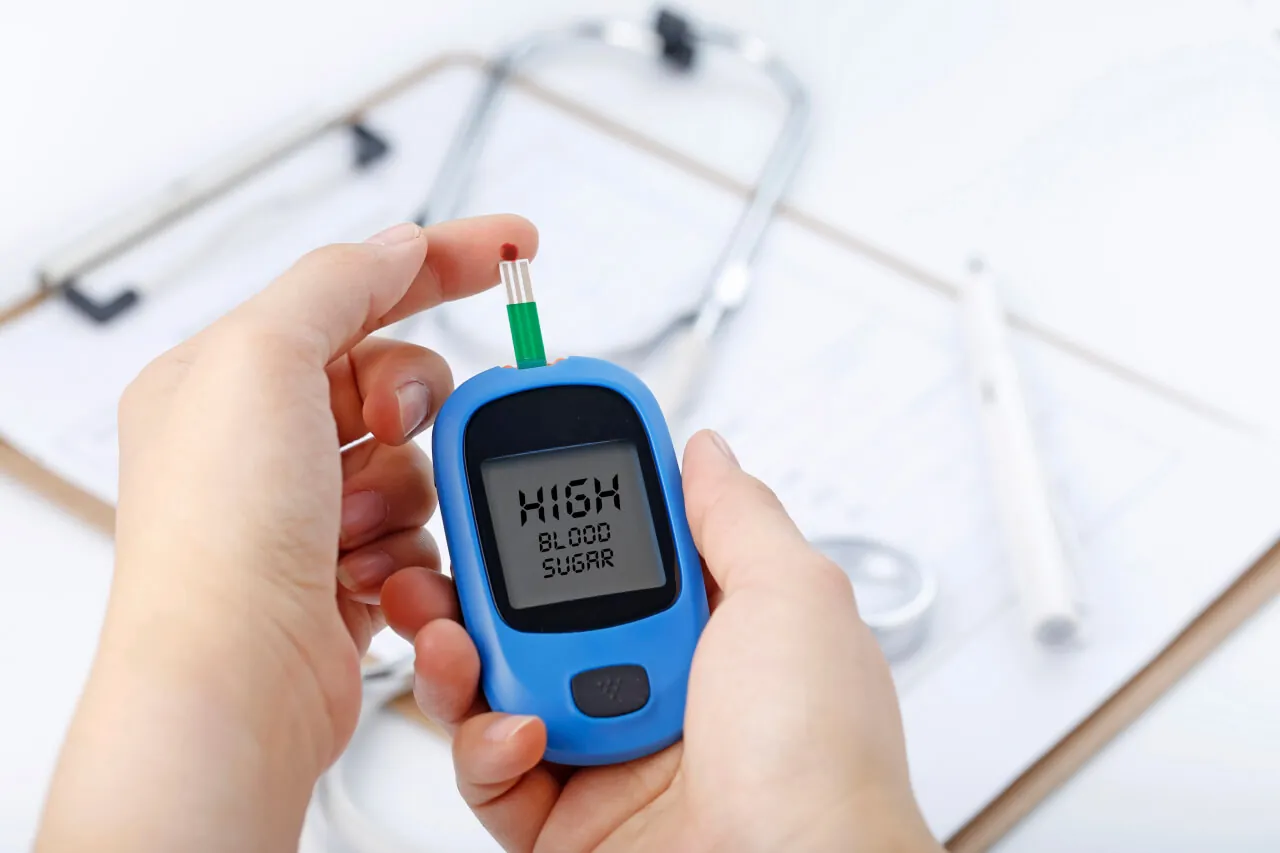Diabetes is a chronic condition that affects how the body uses glucose, a type of sugar that is the main source of energy for cells.
Glucose comes from the food we eat and is transported by the blood to cells where it is used or stored.
Insulin is a hormone that helps cells take glucose from the blood.
When the body doesn’t produce enough insulin or doesn’t use it properly, glucose accumulates in the blood, leading to high blood sugar levels.
This can cause various health problems, including damage to nerves, blood vessels, eyes, kidneys, and the heart. There are two main types of diabetes: type 1 and type 2.
This article focuses on type 2 diabetes, which is the most common form, affecting around 90% of people with diabetes.
We will explain what type 2 diabetes is, its symptoms and causes, and how it can be treated.
What is Type 2 Diabetes?
Type 2 diabetes occurs when the body becomes resistant to insulin, meaning that cells do not respond well to the hormone and do not take enough glucose from the blood.
As a result, the pancreas has to produce more insulin to try to lower blood sugar levels.
However, over time, it may not keep up with the demand.
This leads to a situation where blood sugar levels are too high (hyperglycemia), and cells lack glucose (hypoglycemia).
Type 2 diabetes usually develops gradually over many years and often goes unnoticed until complications arise.
It is more common in older adults but can also affect younger people, especially those who are overweight or obese, have a family history of diabetes, or belong to certain ethnic groups.
Type 2 diabetes can also be triggered by certain medications, infections, or illnesses.
Symptoms and Causes of Type 1
Diabetes Type 1 diabetes occurs when the immune system mistakenly attacks and destroys insulin-producing cells in the pancreas, leaving the body with little or no insulin.
This results in rapidly and dangerously elevated blood sugar levels, causing cells to lack glucose.
Type 1 diabetes is also known as insulin-dependent diabetes or juvenile diabetes because it usually develops in childhood or adolescence, although it can occur at any age.
Symptoms of type 1 diabetes can appear suddenly and include increased thirst and urination, extreme hunger, unintentional weight loss, fatigue, weakness, blurred vision, nausea, vomiting, fruity breath odor, and abdominal pain.
The exact cause of type 1 diabetes is unknown, but it is believed to be a combination of genetic and environmental factors.
With possible triggers such as viral infections, exposure to toxins or chemicals, dietary factors, stress, or trauma.
Symptoms and Causes of Type 2 Diabetes
Type 2 diabetes is a condition that occurs when the body becomes resistant to insulin, meaning that cells do not respond well to the hormone and do not take enough glucose from the blood.
As a result, the pancreas has to produce more insulin to try to lower blood sugar levels. However, over time, it may not keep up with the demand.
This leads to a situation where blood sugar levels are too high (hyperglycemia), and cells lack glucose (hypoglycemia).
Symptoms of type 2 diabetes often develop slowly and may not be noticeable at first.
They can include increased thirst and urination, increased hunger, unintentional weight loss or gain, fatigue, irritability, blurred vision, slow-healing wounds or infections, numbness or tingling in the hands or feet, dark patches on the skin, especially on the neck or armpits.
The main cause of type 2 diabetes is insulin resistance, influenced by various factors such as being overweight or obese, especially having excess fat around the abdomen.
Leading a sedentary lifestyle with little or no physical activity, having a family history of diabetes, or a personal history of gestational diabetes.
Certain medical conditions, including
- polycystic ovary syndrome
- high blood pressure
- high cholesterol
- fatty liver disease
And certain ethnic backgrounds, such as
- African
- Asian
- Hispanic
- Native American
Also, it contributes to the risk.
Aging also plays a role, as the body becomes less sensitive to insulin over time.
How to Treat Each Type of Diabetes
There is no cure for diabetes, but it can be controlled with proper care and treatment.
The goal of treatment is to maintain blood sugar levels within a healthy range and prevent or delay diabetes complications.
The treatment plan may vary depending on the type and severity of diabetes, as well as individual preferences and needs.
However, some general principles include:
Regularly monitoring blood sugar levels
Using a glucose meter, continuous glucose monitor, or hemoglobin A1c test.
Taking medications as prescribed
such as
- insulin injections
- oral medications
- non-insulin injectables
Following a healthy diet that is balanced
Low in sugar and fat, and high in fiber and protein
Engaging in regular exercise
At least 150 minutes per week, with a combination of aerobic and resistance activities
Managing stress using relaxation techniques, counseling, or support groups
Quitting smoking and limiting alcohol consumption
as they can worsen blood sugar levels and increase the risk of complications
Regularly checking feet, eyes, teeth, and kidneys, and seeking medical attention
if any issues arise; having regular check-ups with healthcare providers and following their recommendations.
Early Detection
Early detection and diagnosis of type 2 diabetes are crucial for effective management and prevention of complications.
In this section, let’s delve into key aspects surrounding early detection and diagnosis of type 2 diabetes.
Regular Health Check-ups
Emphasize the importance of routine health check-ups, especially for individuals with risk factors such as obesity, family history, and age.
Encourage adults to undergo regular screening tests, including blood glucose tests, to detect any abnormalities.
Knowing Risk Factors
Educate people about risk factors associated with type 2 diabetes, such as age, family history, sedentary lifestyle, and certain ethnic backgrounds.
Encourage those at higher risk to be more vigilant about their health and seek professional advice.
Recognizing Common Symptoms
Highlight common symptoms of type 2 diabetes, such as increased thirst, frequent urination, unexplained weight loss, fatigue, blurred vision, and slow wound healing.
Emphasize the importance of not ignoring these symptoms and seeking immediate medical attention.
Blood Glucose Tests
Explain the importance of blood glucose tests as a primary diagnostic tool for diabetes.
Describe different types of tests, including fasting blood glucose, oral glucose tolerance test (OGTT), and HbA1c, and their role in diagnosing type 2 diabetes.
Point-of-Care Testing
Discuss advances in point-of-care testing, allowing quicker and more convenient diabetes detection.
Highlight the benefits of rapid results, especially in identifying those at risk who need further evaluation.
Screening Guidelines
Provide information on screening guidelines established by health organizations and medical professionals.
Emphasize the importance of following these guidelines, especially for individuals with risk factors, to ensure early detection and timely intervention.
Regular Monitoring for High-Risk Groups
Advocate for regular monitoring of blood glucose levels in high-risk groups, such as individuals with prediabetes, gestational diabetes, or a family history of diabetes.
Emphasize the potential benefits of early intervention to prevent progression to type 2 diabetes.
Professional Guidance
Encourage individuals to consult healthcare professionals for a comprehensive assessment if they suspect they may have diabetes.
Emphasize the role of healthcare providers in interpreting test results, providing accurate diagnoses, and developing personalized management plans.
Lifestyle and Behavioral Changes
Highlight the importance of lifestyle changes to prevent or manage type 2 diabetes.
Encourage people to adopt a healthy diet, engage in regular physical activity, and manage stress as part of a proactive approach to diabetes prevention.
By raising awareness about the importance of early detection and diagnosis, readers can take proactive steps to care for their health.
Lifestyle Factors in Type 2 Diabetes Development and Prevention
In this section, we will explore key lifestyle changes and risk reduction strategies that individuals can adopt to decrease their risk of developing Type 2 Diabetes.
Healthy Eating Habits
Promote balanced and nutritious diet rich in whole grains, fruits, vegetables, lean proteins, and healthy fats.
Emphasize portion control and the importance of minimizing the consumption of processed foods, sugary beverages, and high-calorie snacks.
Regular Physical Activity
Advocate for regular exercise, aiming for at least 150 minutes of moderate-intensity aerobic activity per week.
Highlight the benefits of physical activity in improving insulin sensitivity, promoting weight control, and reducing the risk of Type 2 Diabetes.
Weight Management
Emphasize the connection between obesity and Type 2 Diabetes, encouraging the maintenance of a healthy weight.
Provide practical advice for weight control, including mindful eating, regular exercise, and setting realistic goals.
Avoiding Sedentary Behavior
Educate individuals about the negative impact of prolonged sitting on health.
Encourage breaks from sedentary activities, such as standing, stretching, or taking short walks, to promote overall well-being and reduce the risk of diabetes.
Hydration and Moderate Alcohol Consumption
Highlight the importance of staying hydrated with water as the primary beverage.
Advise moderation in alcohol consumption, as excessive intake can contribute to weight gain and increase the risk of Type 2 Diabetes.
Stress Management
Emphasize the relationship between chronic stress and an increased risk of diabetes.
Encourage stress-reducing activities, such as meditation, deep breathing exercises, yoga, or engaging in hobbies, to promote overall mental well-being.
Smoking Cessation
Stress the detrimental effects of smoking on overall health, including an elevated risk of Type 2 Diabetes.
Provide resources and support for those looking to quit smoking.
Regular Health Check-ups
Advocate for regular health check-ups to monitor blood pressure, cholesterol levels, and blood glucose.
Highlight the importance of early detection and intervention to manage risk factors associated with Type 2 Diabetes.
Knowledge and Awareness
Empower individuals with knowledge about the risk factors and symptoms of Type 2 Diabetes.
Encourage regular health education and awareness campaigns to promote a proactive approach to health.
Family and Community Support
Highlight the role of family and community support in adopting and sustaining healthy lifestyle changes.
Encourage collective efforts in creating environments that foster healthy eating and active living.
Conclusion
Type 2 Diabetes is a common and serious condition that affects how the body uses glucose, a type of sugar crucial for cell energy.
It occurs when the body becomes resistant to insulin, leading to elevated blood sugar levels and low cellular glucose.
This can result in various health problems, including nerve damage, eye damage, kidney damage, and heart disease.
Type 2 Diabetes can be prevented or delayed through maintaining a healthy weight, regular physical activity, a balanced diet, and avoiding smoking and excessive alcohol consumption.
It can also be managed with medications, diet, exercise, and regular monitoring.
By following these steps, individuals with Type 2 Diabetes can lead a long and healthy life.
FAQs
What causes Type 2 Diabetes?
Type 2 Diabetes is primarily caused by a combination of genetic and lifestyle factors.
Risk factors include family history, obesity, sedentary lifestyle, and poor diet, contributing to insulin resistance, a key element in Type 2 Diabetes development.
How can I identify symptoms of Type 2 Diabetes?
Common symptoms of Type 2 Diabetes include increased thirst, frequent urination, unexplained weight loss or gain, fatigue, blurred vision, slow wound healing, and numbness or tingling in the extremities.
Consult a healthcare professional for proper diagnosis if these symptoms occur.
Can Type 2 Diabetes be prevented?
While genetic predisposition cannot be changed, adopting a healthy lifestyle significantly reduces the risk.
Maintaining a balanced diet, engaging in regular physical activity, and managing stress can help prevent the onset.
Are there risk factors for developing Type 2 Diabetes?
Yes, several risk factors increase the likelihood of developing Type 2 Diabetes.
These include age, family history, obesity, lack of physical activity, and certain ethnic backgrounds (African, Asian, Hispanic, Native American).
What role does diet play in managing Type 2 Diabetes?
Diet plays a crucial role in managing Type 2 Diabetes.
A balanced diet with controlled carbohydrate intake, emphasis on whole foods, and portion control helps regulate blood sugar levels.
Consult a healthcare professional or dietitian for personalized dietary guidance.
Can Type 2 Diabetes be reversed?
In some cases, lifestyle modifications such as weight loss, regular exercise, and a healthy diet can lead to remission of Type 2 Diabetes.
Individual responses vary, and any changes in management should be discussed with a healthcare provider.
Early detection and intervention increase the chances of successful management.





